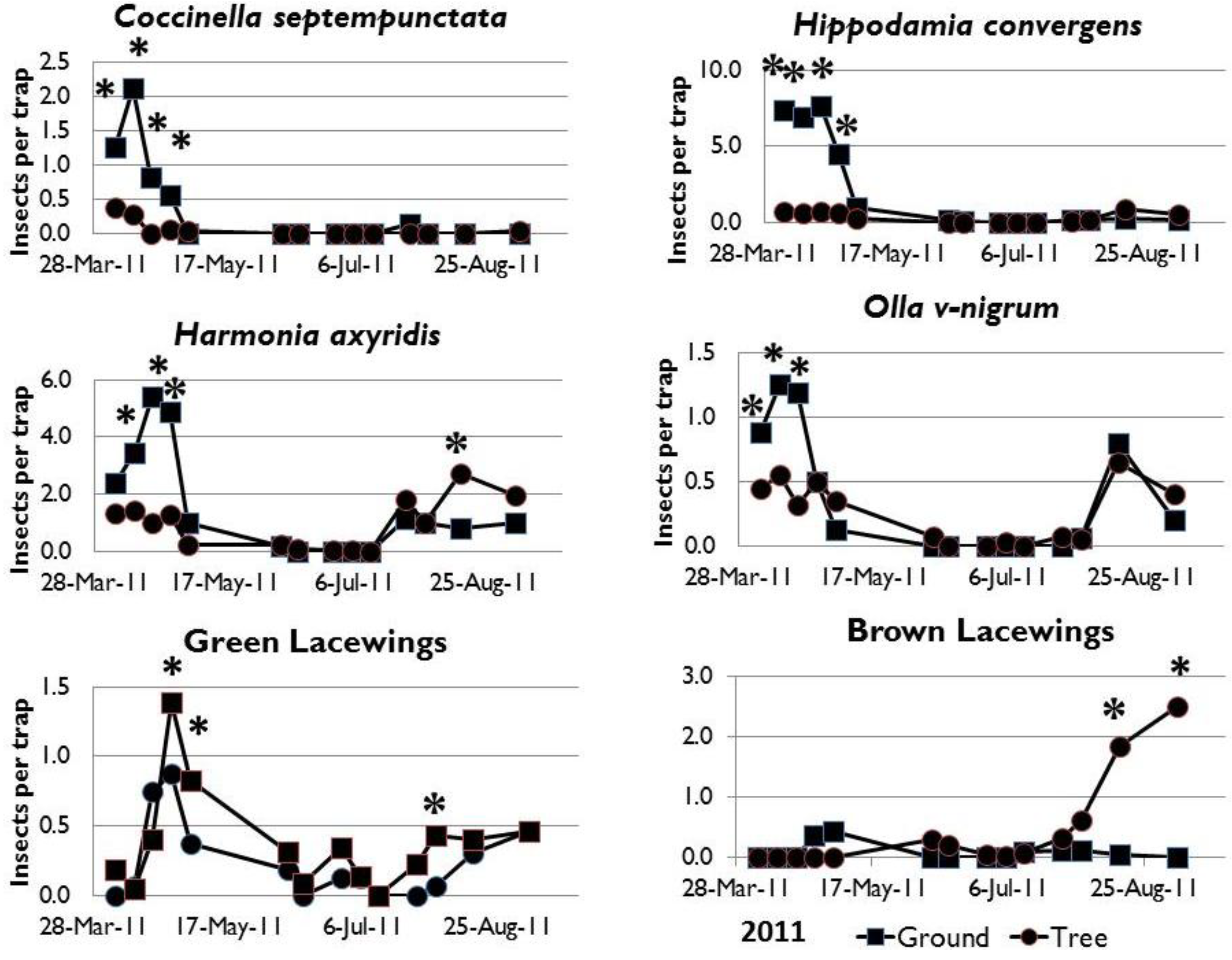Seasonal Abundance of Aphids and Aphidophagous Insects in Pecan
Abstract
:1. Introduction
2. Results and Discussion
2.1. Seasonal Occurrence of Aphids and Aphidophagous Insects


2.2. Effect of “Food Spray” on Abundance of Aphids and Aphidophagous Insects

3. Experimental Section
3.1. Seasonal Occurrence of Aphids and Aphidophagous Insects
- (1)
- of yellow pecan aphids = # YPA + RYPA:BMA × #YAN.
- (2)
- of blackmargined aphids = # BMA + RBMA:YPA × #YAN.
- (3)
- black pecan aphids = # BPA + # BPN.
3.2. Effect of “Food Spray” on Abundance of Aphids and Aphidophagous Insects
4. Conclusions
Acknowledgments
References
- Payne, J.A. Insect Pests and Diseases of the Pecan; U.S. Department of Agriculture, Science and Education Administration, Agriculture Reviews and Manuals ARM-5-5: Washington, DC, USA, 1979; p. 43. [Google Scholar]
- Dutcher, J.D.; Harris, M.K.; Dean, D.A. Integration of chemical and biological insect control in native, seedling, and improved pecan production. Southw. Entomol. 2003, 27, 142. [Google Scholar]
- Dutcher, J.D.; Fonsah, E.G.; Hudson, W.G. Management of insect and mite pests in pecan orchards. Recent Res. Devel. Entomol. 2006, 5, 95–109. [Google Scholar]
- Tedders, W.L. Important biological and morphological characteristics of the foliar-feeding aphids of pecan. USDA Tech. Bull. 1978, 1579, 29. [Google Scholar]
- Pecan Pest and Disease Management. Available online: http://wiki.bugwood.org/Pecan_pest_and_disease_management#Insect_Pests/ (accessed 14 August 2012).
- Edelson, J.V.; Estes, P.M. Intracanopy distribution and seasonal abundance of the yellow pecan aphids Monellia caryella and Monelliopsis nigropunctata (Homoptera: Aphididae). Environ. Entomol. 1983, 12, 862–867. [Google Scholar]
- Edelson, J.V.; Estes, P.M. Intracanopy distribution and seasonal abundance of the yellow abundance and distribution of predators and parasites associated with Monelliopsis pecanis Bissell and Monellia caryella (Fitch) (Homoptera: Aphidae). J. Entomol. Sci. 1987, 22, 336–347. [Google Scholar]
- Abbas, G.; Karar, H.; Dutcher, J.D. Efficacy of multicolored Asian ladybeetle (Coleoptera: Coccinellidae) as a control for aphids in pecan orchards. J. Entomol. Sci. 2012, in press. [Google Scholar]
- Williamson, J. Encouragement of aphid predators in pecan orchards. Ph.D. Dissertation, Entomology Department, University Georgia, Athens, GA, USA, 2009. [Google Scholar]
- Dutcher, J.D. A review of resurgence and replacement causing pest outbreaks in IPM. In General Concepts in Integrated Pest and Disease Management; Ciancio, A., Mukerji, K.G., Eds.; Springer: Dordrecht, The Netherlands, 2007; pp. 27–43, Section 1. [Google Scholar]
- LaRock, D.R.; Ellington, J.J. An integrated pest management approach, emphasizing biological control, for pecan aphids. Southw. Entomol. 1996, 21, 153–167. [Google Scholar]
- Sparks, D. Pecan Cultivars the Orchard’s Foundation; Pecan Production Innovations: Watkinsville, GA, USA, 1992; p. 443. [Google Scholar]
- Karar, H.; Abbas, G.; Dutcher, J.D. Pecan cultivar differences in aphid reproduction and abundance. J. Entomol. Sci. 2012, 47, 1–6. [Google Scholar]
- Wade, M.R.; Zalucki, M.P.; Wratten, S.D.; Robinson, K.A. Conservation biological control of arthropods using artificial food sprays: Current status and future challenges. Biol. Control 2008, 45, 185–199. [Google Scholar] [CrossRef]
- Dutcher, J.D. Habitat manipulation for enhancement of aphidophagous insects in pecan orchards. Int. J. Ecol. Environ. Sci. 1994, 30, 13–22. [Google Scholar]
- Hagley, E.A.C.; Simpson, C.M. Effect of food sprays on numbers of predators in an apple orchard. Can. Entomol. 1981, 113, 75–77. [Google Scholar] [CrossRef]
- Kaakeh, W.; Dutcher, J.D. Estimation of life parameters of Monelliopsis pecanis, Monellia caryella, and Melanocallis caryaefoliae (Homoptera: Aphididae) on single pecan leaflets. Environ. Entomol. 1992, 21, 632–639. [Google Scholar]
- Tedders, W.L.; Gottwald, T.R. Flight behavior of Monellia caryella, Monelliopsis pecanis, and Melanocallis caryaefoliae (Homoptera: Aphididae) during M. caryella population crashes. In Aphids and Phylloxeras of Pecan; Neel, W.W., Tedders, W.L., Dutcher, J.D., Eds.; College of Agricultural Special Publication, University Georgia: Athens, GA, USA, 1983; Volume 38, pp. 51–57. [Google Scholar]
- Pickering, J.; Dutcher, J.D.; Ekbom, B.S. The effect of fungicide on fungal-induced mortality of pecan aphids (Homoptera: Aphididae) in the field. J. Econ. Entomol. 1990, 83, 1801–1805. [Google Scholar]
- Dutcher, J.D. Conservation of aphidophaga in pecan orchards. In Conservation Biological Control; Barbosa, P., Ed.; Academic Press: New York, NY, USA, 1998; p. 396. [Google Scholar]
- Kaakeh, W.; Dutcher, J.D. Survival of yellow pecan aphids and black pecan aphids (Homoptera: Aphididae) at different temperature regimes. Environ. Entomol. 1993, 22, 810–817. [Google Scholar]
- Kaakeh, W.; Dutcher, J.D. Effect of rainfall on populations of aphids (Homoptera: Aphididae) on pecan. J. Entomol. Sci. 1993, 28, 283–286. [Google Scholar]
- PopTools Version 3.2.5. Available online: http://www.poptools.org/ (accessed on 7 August 2012).
- Tedders, W.L.; Schaefer, P.W. Release and establishment of Harmonia axyridis (Coleoptera: Coccinellidae) in the southeastern United States. Entomol. News 1994, 105, 228–243. [Google Scholar]
© 2012 by the authors; licensee MDPI, Basel, Switzerland. This article is an open access article distributed under the terms and conditions of the Creative Commons Attribution license (http://creativecommons.org/licenses/by/3.0/).
Share and Cite
Dutcher, J.D.; Karar, H.; Abbas, G. Seasonal Abundance of Aphids and Aphidophagous Insects in Pecan. Insects 2012, 3, 1257-1270. https://doi.org/10.3390/insects3041257
Dutcher JD, Karar H, Abbas G. Seasonal Abundance of Aphids and Aphidophagous Insects in Pecan. Insects. 2012; 3(4):1257-1270. https://doi.org/10.3390/insects3041257
Chicago/Turabian StyleDutcher, James D., Haider Karar, and Ghulam Abbas. 2012. "Seasonal Abundance of Aphids and Aphidophagous Insects in Pecan" Insects 3, no. 4: 1257-1270. https://doi.org/10.3390/insects3041257



